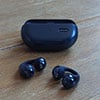We may earn commissions when you buy from links on our site. Why you can trust us.
All the Phones That Have Satellite Messaging in 2025
Recent natural disasters have highlighted a critical need: the ability to communicate even if cellular service fails. Text messaging via satellite can be a lifeline in such situations, allowing you to reach emergency services or let loved ones know you're safe.
Satellite messaging is a relatively new feature in the smartphone world, having made its debut in smartphones just a couple of years ago. The feature works anywhere in the continental U.S. with an unobstructed view of the sky and select other countries. You can’t choose to use satellite service; it’s a backup communication method that only works when traditional cellular networks are unavailable. And since it is intended for emergencies, messaging is limited to just text (you're not going to be uploading selfies from the middle of Death Valley).
Phones need specific radios to connect directly to satellites orbiting Earth and it's not a standard feature you'll find on every device. In fact, it's currently limited to select models from Apple (iPhone 14 and later) and Google (Pixel 9 series), and, shortly, the Samsung Galaxy S25 series.
Apple and Google have agreements with Skylo, a satellite service provider, that enable users of their phones to send free SOS messages to emergency services, and, in the case of iPhone users, to their emergency contacts and members of their Family Group. Samsung doesn't have an agreement with a satellite provider, so you'll need to rely on your carrier to offer the satellite service. To date, Verizon, which has partnered with Skylo, and T-Mobile, which is partnering with Skylink, are offering Emergency SOS texting to Galaxy S25 series owners.
Full details on the satellite services and availability for iOS and Android models are described below.
A Google Pixel 9 Pro shows the Pixel Satellite SOS demo screen.
Using Satellite Messaging with your iPhone
Apple has integrated satellite messaging into its recent flagship models: the iPhone 14, 15, and 16 series, plus the 16e. These devices, running iOS 18 or later, offer a range of satellite-enabled services:
- Emergency SOS: Connect with emergency services when cellular and Wi-Fi aren't available.
- Roadside Assistance: Get help when your car breaks down in remote areas.
- Find My: Share your location via satellite.
- iMessage and SMS via satellite: Communicate with contacts when off the grid.
Read more: New iPhone 16 Models Look Great, But Mostly Just Keep Up with the Pack
Using satellite messaging on iPhones is straightforward. You don't need any setup for emergency services – just a clear view of the sky. And you need to be in a country that supports the service: the continental United States (Alaska and Hawaii aren't guaranteed), Australia, Austria, Belgium, Canada, France, Germany, Ireland, Italy, Japan, Luxembourg, the Netherlands, New Zealand, Portugal, Spain, Switzerland, and the U.K. If you text emergency services (911 for the U.S. or the country's equivalent), Apple will automatically send along your GPS location, medical ID information (if you filled it out on your iPhone in the Health app), and emergency contacts.
Read more: How to Set up Your Medical ID and Emergency Contacts for iPhone SOS
For iMessage via satellite, you'll need to enable iMessage and have recently messaged your intended recipients before heading to an area without cellular coverage. If you want to send messages to Android users, you'll go into Settings > Apps > Messaging and toggle off "iMessages" to ensure that plain SMS text messages are sent (iPhone users will receive these, too).
I've tested satellite messaging on my iPhone 14 Pro, and while it's not as quick as regular messaging, it's reassuring to know it's there when you need it. You can test satellite messaging on your own device by going to Settings > Emergency SOS and selecting "Try Demo."
Apple includes Emergency SOS service for two years with your device after activation (iPhone 14 owners will get service until September 2025). Apple hasn't announced what happens after that.
Using Satellite Messaging with Android Phones
On the Android side, satellite messaging is currently limited to Google's Pixel 9 series phones and Samsung Galaxy S25 series models on Verizon and T-Mobile. SamMobile is reporting that users of the Galaxy S24 series phones and the Galaxy Z Fold 6 have seen "Satellite Networks" in their settings menu, so these phones likely have the capability for future support, as well.
The Pixel 9 phones offer Emergency SOS via satellite, allowing you to contact emergency services when you're out of cellular range. Google will send along your GPS location and emergency contacts. This feature is available in the United States (including Hawaii and Alaska), Canada, and Europe.
To use satellite messaging on Pixel phones, you must have Google Messages as your default messaging app. In an emergency without cellular service, you dial (not text) 911, then use the Satellite SOS option that appears.
If you want to see how it works, you can try the demo by going to Settings > Safety & emergency > Satellite SOS and following the prompts.
Like Apple, Google has included this service for two years. And, like Apple, Google hasn't told us what the plan is post-two years.
Read more: Google Pixel 9 Smartphone Lineup Adds Plenty of New AI Features
Samsung Galaxy S25 phone owners that have Verizon as their carrier will have Satellite SOS messaging via Skylo. You'll be able to check to see if your Galaxy phone has satellite connectivity by going to Settings > Connections >Satellite Networks.
Read more: Samsung Galaxy S25 Wants to Be Your Personal Assistant
Upcoming Developments
While satellite messaging is currently limited to these high-end phones, that's set to change. T-Mobile and SpaceX are collaborating to bring satellite connectivity to existing phones on T-Mobile's network, potentially bringing satellite messaging to millions of users without requiring new hardware. This service would use Starlink satellites and T-Mobile's mid-band spectrum to provide coverage almost anywhere with a view of the sky.
Read more: How to Sign Up for T-Mobile’s Free Satellite Connectivity Beta
During Hurricane Milton, T-Mobile and Starlink received FCC approval to operate their Direct-to-Cellular service in affected areas, enabling wireless emergency alerts and SMS to 911 in Florida and regions impacted by Hurricane Helene.
T-Mobile recently opened up registration for beta testing of its Starlink satellite-to cell service to T-Mobile, AT&T, and Verizon customers. The company says there will be limited openings, but if you are accepted into the beta, the service will be free through July 2025.
Updated on 3/8/2025 with expanded Satellite coverage for Pixel 9 phones.
[image credit: Techlicious]
For the past 20+ years, Techlicious founder Suzanne Kantra has been exploring and writing about the world’s most exciting and important science and technology issues. Prior to Techlicious, Suzanne was the Technology Editor for Martha Stewart Living Omnimedia and the Senior Technology Editor for Popular Science. Suzanne has been featured on CNN, CBS, and NBC.


















From Darren Williams on March 21, 2025 :: 12:16 pm
Please let me know when Samsung has satellite communications on their z-fold phone. I love the phone but will wait to see if the new version will have satellite communications when out of cell range.
Reply